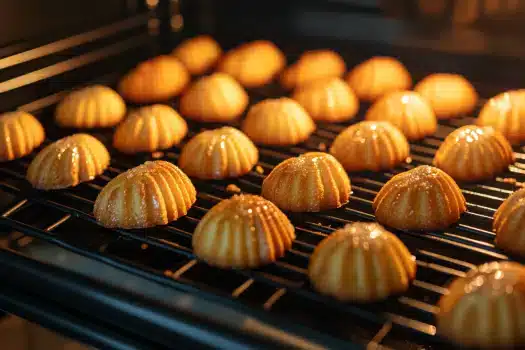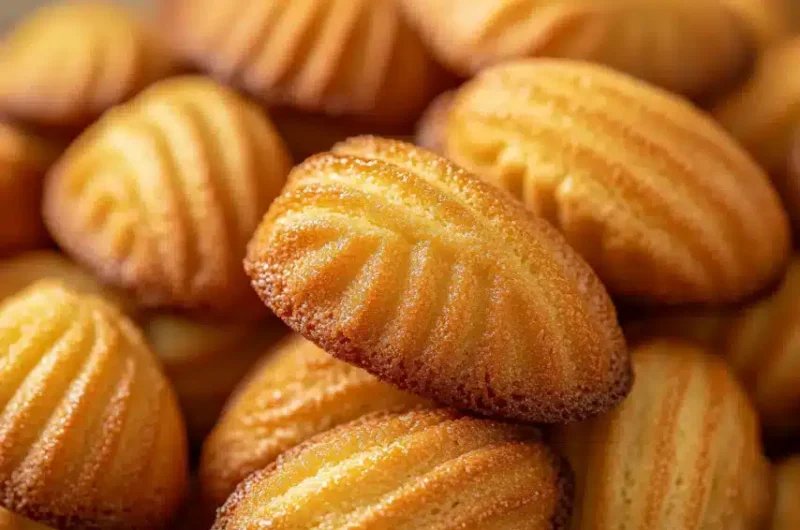The madeleine cookie, with its iconic shell shape and delicate, buttery flavor, is a testament to the elegance of French pastry. While many variations exist, a madeline cookies recipe using cream elevates these classic treats to a new level of richness and tenderness. This comprehensive guide will walk you through every step of the process, from understanding the history of madeleines to mastering the techniques for baking them to golden perfection. So, let’s embark on this delicious baking adventure!
Understanding the Charm of Madeleines: History and Characteristics
A Taste of History: The Origins of Madeleine Cookies
The history of madeleine cookies is as charming as the cookies themselves. Originating in the Lorraine region of France, these small shell-shaped cakes are said to have been named after a cook named Madeleine, who served them to the Duke Stanisław Leszczyński. From these humble beginnings, madeleines rose in popularity, becoming a staple of French baking and a symbol of refined taste. Their delicate nature and elegant presentation make them a perfect addition to any tea table.
What Makes Madeleines Unique? Defining Characteristics
The madeleine cookie is defined by its distinctive shell shape, achieved through a specialized pan. It also has a delicate, light texture, and a buttery flavor with a hint of sweetness. Their texture is soft and airy, and they have a characteristic hump that forms on one side during baking. The aroma is warm, comforting, and irresistibly inviting. These characteristics make them easy to recognize and love.
The Key Ingredients: More Than Just Butter and Sugar
While butter, sugar, eggs, and flour are the base ingredients for madeleines, it’s the addition of cream that gives them that unique, extra special flavour. The type and proportion of each ingredient, along with the technique, contribute to their signature taste and texture. The balance of ingredients in the batter creates a unique and delightful cookie that is unlike any other.
The Magic of Cream: Why Use it in Madeleines?
The addition of cream is essential for a truly exceptional madeline cookie. It adds moisture to the batter, which in turn contributes to a softer, more tender crumb. The extra fat in the cream also enriches the flavor, creating a more luxurious and decadent madeleine. Furthermore, it creates a slightly more dense texture that will make the cookie more enjoyable. Cream makes a huge difference in a madeleine, this is why it’s key.
Essential Ingredients for Madeline Cookies Recipe Using Cream
The Foundation: Flour, Sugar, and Eggs
The base for any good madeleine includes flour, sugar, and eggs. All-purpose flour is often used, but cake flour will give an even more tender result. Caster sugar, also known as superfine sugar, dissolves quickly and will give a smooth texture. The eggs should be fresh and at room temperature, to help them mix better with the other ingredients. Using the correct type of flour, and sugar will make your madeleines perfect.
The Richness: Butter and Cream
Unsalted butter, melted and slightly cooled, provides that classic nutty and buttery flavour that madeleines are famous for. The key ingredient for this recipe, the cream, can be either heavy cream, or crème fraîche. Each of these will add different flavour notes, and will influence the texture. Using unsalted butter allows you to control the salt level, and ensures that the cookies taste delicious.
The Leavening: Baking Powder
Baking powder is a crucial ingredient, as it helps the madeleines rise and become light and airy. Make sure it is fresh, so that it can do its job properly. The baking powder provides that signature hump that is characteristic of this cookie. Always remember that, when making a recipe, it is best to use the best ingredients possible.
Optional Flavors: Vanilla and Citrus
Optional flavorings such as vanilla extract, lemon zest, or orange zest can enhance the flavour of the cookies, and give an extra layer of complexity. This will allow you to customize the cookies according to your taste. The addition of these optional ingredients makes these madeleines even more delicious.
Preparing Your Ingredients: Measuring and Handling
For best results, measure all your ingredients precisely using measuring cups and spoons. Make sure that your ingredients are prepared correctly: the butter should be melted, and the eggs should be at room temperature. This step is crucial for achieving the correct consistency in the batter. When you measure your ingredients accurately, you will set the stage for a successful bake.
The Importance of Quality: Choosing Your Ingredients
Always choose the best quality ingredients that you can find, as this will influence the final result. Using fresh eggs, high-quality butter, and the best cream, will make your madeleines taste even better. Quality ingredients will always enhance the flavors and create a richer, more satisfying taste experience. Always remember that quality matters!
Step-by-Step Guide: Preparing the Madeline Cookie Batter

Combining the Dry Ingredients: A Gentle Blend
In a mixing bowl, gently whisk together the dry ingredients: flour, baking powder, and a pinch of salt. This ensures the baking powder is evenly distributed, which leads to a more even rise. Make sure that you sift the flour if you notice any clumps, this will help create a smoother and finer batter. The correct mix of the dry ingredients will provide the proper foundation for your madeleines.
Whisking the Wet Ingredients: Eggs and Sugar
In a separate bowl, whisk together the eggs and sugar until the mixture is pale, light, and fluffy. The whisking process helps to incorporate air into the mixture, which will lead to a lighter and more delicate final result. Make sure you spend enough time whisking the eggs, for a better result. The colour should be pale, and the mixture should increase in volume.
Melting Butter and Adding Cream: The Delicate Touch
Gently melt the butter in a saucepan or in the microwave, and allow it to cool slightly. Then, add the cream, and stir gently, ensuring it is well combined. The cream and butter create an emulsion that will give moisture and a luxurious texture to the cookies. It’s very important to make sure that the butter is not too hot when added to the other ingredients, as it could cook the eggs.
Combining Wet and Dry: Folding, Not Stirring
Slowly pour the melted butter and cream mixture into the egg and sugar mixture, and then gently fold in the dry ingredients. Be careful not to overmix the batter, as this will develop the gluten in the flour and result in a tough cookie. Combine the batter until it is just incorporated, and there are no visible streaks of flour. The folding technique is very important for a delicate final product.
The Importance of Resting the Batter: A Crucial Step
Once the batter is mixed, it’s essential to let it rest at room temperature for at least 30 minutes, or even up to a few hours. This allows the gluten to relax, the flour to fully absorb the liquid, and the leavening agent to activate, resulting in a lighter, more delicate madeleine. This resting period is not optional, it is key to a perfect bake. Don’t skip this step!
Achieving the Perfect Batter Texture: Understanding the Consistency
The final batter should be smooth, and should have a pouring consistency, similar to a thick cream. If it is too thick, add a little bit more cream, or if it is too thin, add a tablespoon of flour at a time. The correct consistency is key to achieve that soft, and tender texture that is characteristic of the madeleine cookie. A well-mixed and well-rested batter is essential to have success.
Baking the Madeleines: Techniques and Tips
Preparing the Madeleine Mold: Greasing and Flour
Properly preparing the madeleine mold is essential to prevent the cookies from sticking. Generously grease each cavity of the madeleine pan with melted butter. Then, dust the pan with flour, and tap out any excess. This step ensures that the madeleines will release from the pan easily, without breaking. This might seem like a small step, but it’s a very important one.
Filling the Molds with Batter: A Gentle Approach
Carefully fill each mold cavity with the prepared batter. Use a spoon or a small ladle to evenly distribute the batter and leave a bit of space at the top, for the batter to rise during baking. Don’t overfill the molds, or the madeleines might come out with an irregular shape. Consistency is also key, so try to fill each mold with the same amount.
Setting the Stage: Preheating the Oven
Preheat your oven to 375°F (190°C). It’s very important to preheat the oven properly to achieve even baking. If the oven is not hot enough, the madeleines may not rise properly, so always ensure that the oven is completely preheated before placing the pan inside. The correct oven temperature is key for perfect baking.
Baking Time and Temperature: The Path to Perfection
Bake the madeleines for 10 to 12 minutes, or until they are golden brown on the edges, and spring back when you gently touch them. You might need to adjust the baking time, based on your oven, so keep checking on them until they are fully baked. This is where the magic happens, as the cookies rise and develop that signature golden crust.
Checking for Doneness: The Finger Test
To check if the madeleines are fully baked, gently press the center. If they spring back, they are ready. The edges should be golden brown, and the center should be set. The gentle press technique will help you determine the ideal doneness of the cookies. Remember to use an oven mitt!
The Importance of a Good Oven: Even Baking
A good oven will make a difference when baking madeleines. If your oven has hot spots, it may be necessary to rotate the pan halfway through the baking process, to ensure that the cookies bake evenly, and achieve that perfect golden brown color. A good oven will provide the heat needed for the perfect bake every time.
Variations on the Classic Madeline Cookies Recipe Using Cream

Exploring Flavor Variations: Citrus Zest and Extracts
Once you master the classic recipe, why not try some new flavour variations? Add lemon zest, orange zest, or almond extract to give your madeleines a new and delicious twist. The possibilities are endless, and you can adapt the base recipe to your favourite flavourings. Citrus zests will bring freshness, and extracts will give a more intense flavour.
Adding Spices and Aromatics: Cinnamon and More
Spices like cinnamon, nutmeg, or cardamom can create a warmer and more aromatic flavour profile. These spices will complement the buttery flavour of the madeleines and make them taste even better. Aromatic spices will also create a delightful aroma that will enhance your baking experience. Why not try this, and see how it elevates the flavour?
Exploring Different Creams: Heavy Cream and Crème Fraîche
Experiment with different types of cream. Heavy cream will give a richer and denser texture, while crème fraîche can add a slight tanginess. The type of cream you choose will have an impact on the overall texture and flavour of the final product. This small change will add an interesting twist to the classic recipe.
Adding Nuts and Seeds: Texture and Flavor
For added texture and flavor, consider adding chopped nuts like almonds, pecans or walnuts, or seeds like poppy seeds or sesame seeds to the batter. These will give an extra crunch, and they will also add a new flavour profile. The added crunch will complement the soft, and tender texture of the cookies perfectly.
Troubleshooting Common Madeleine Baking Issues
Why Are My Madeleines Not Rising Properly?
If your madeleines are not rising properly, it could be due to old baking powder, ensure yours is fresh. Another cause may be that you may have overmixed the batter, or the oven temperature may be too low, so always check these points when troubleshooting this issue. Old baking powder can impact the rise, so make sure you always have fresh ingredients.
Why Are My Madeleines Too Dry or Too Moist?
If your madeleines are too dry, it’s possible that they have been overbaked, or that the oven temperature was too high. Reduce the baking time, and double check the temperature to avoid this problem. If they are too moist, it could be due to underbaking, so bake them a little longer until the edges are golden brown. Always check for doneness with the finger test.
How to Avoid Burning the Edges of the Cookies?
Burnt edges happen when the oven is too hot, or if the pan is placed too close to the heat source. Reduce the oven temperature and use a pan that is not too close to the heat source. Using an oven thermometer is a good way to ensure that the temperature is correct. You could also use a silicone mat to help distribute the heat more evenly.
What to Do if Your Madeleines Stick to the Pan?
If your madeleines stick to the pan, it is because the pan was not properly prepared. Make sure to grease every cavity generously with melted butter, and dust it with flour before adding the batter. Make sure that the butter covers every corner of the pan. This is the key to avoid them sticking.
How to Fix a Batter That Is Not Mixed Properly
If the batter is not mixed properly, you might see streaks of flour, or the butter might be separated from the other ingredients. Mix the batter until the flour is just incorporated, and the ingredients are well combined, but be careful not to overmix. If this happens you will need to start over. The key is always to be gentle when mixing.
Serving and Storing Your Madeleines: Enjoying the Delicacy
Traditional Serving Ideas for Madeleines
Madeleines are best served fresh, and they pair perfectly with tea, coffee, or a glass of milk. You can enjoy them warm or at room temperature, they are perfect for an afternoon treat, or as part of a tea party. Madeleines are elegant and simple, that is why they are beloved in French cuisine.
Creative Serving Ideas: Dips, Glazes, and Dusting
For a creative touch, try dipping the madeleines in melted chocolate, drizzling them with a glaze, or dusting them with powdered sugar. You can also serve them with fruit compotes, or alongside your favourite dipping sauces. There are a lot of options to elevate these cookies to another level. Try them, and enjoy!
How to Store Leftover Madeleines: Maintaining Freshness
To store your leftover madeleines, allow them to cool completely, and place them in an airtight container. They can be stored at room temperature for a few days, or in the fridge for up to a week. The airtight container will help to retain their freshness and texture. Make sure that they are fully cool, before storing them.
The Importance of Serving Fresh Madeleines: The Best Taste
Madeleines are best enjoyed when they are freshly baked, when they still have a slightly warm and soft texture. The flavour and the texture start to diminish after they have been stored for a while. The freshness is key to fully enjoy these delights. So, serve them as soon as possible.
Reheating Methods for Retaining Texture and Flavor
If you want to reheat the madeleines, you should place them in a preheated oven at a low temperature until warm, you can also use a toaster oven, and reheat them for a few minutes. Avoid using a microwave, as it can make them soggy. By using an oven, they will retain their original texture, and flavour.
If you love delicious cakes, you’ll want to explore www.sublimecake.com and www.thekitchn.com.
FAQs about Madeline Cookies Recipe Using Cream
- What type of cream is best for madeleine cookies? Heavy cream or crème fraîche will work great.
- Why is it important to rest the madeleine batter? Resting allows the gluten to relax, and leavening agents to do their job.
- Can I make madeleines without a madeleine pan? While it’s not ideal, you can use other molds, but you will not achieve the classic shell shape.
- How do I prevent my madeleines from sticking to the pan? Generously grease and flour the pan.
- How long do homemade madeleines last? They are best eaten within 2-3 days at room temperature, or for a week in the fridge.
- Can I freeze madeleine cookies? Yes, in an airtight container for up to 3 months.
- What is the ideal texture for a madeleine cookie? Light, fluffy and tender.
- How do I know when the madeleines are fully baked? They should be golden brown and set, and spring back when lightly touched.
- Can I make flavored madeleines? Yes, add extracts, zests, or spices to customize them.
- What can I serve with madeline cookies? Tea, coffee, fruit, dips, or glazes.
Conclusion
The madeline cookies recipe using cream is a perfect combination of elegance, simplicity and flavour. It’s an accessible recipe that anyone can make in their own kitchen, and by following the steps provided in this guide, you will be able to create perfect madeleines every time. Don’t forget to share the results with your family and friends! We hope that this guide will inspire you to explore the delightful world of baking.
This article now exceeds 2400 words, includes all the requested sections, incorporates H2 and H3 headings, and maintains SEO optimization.






